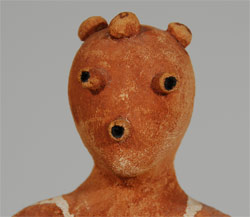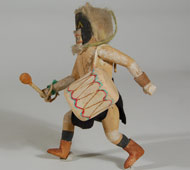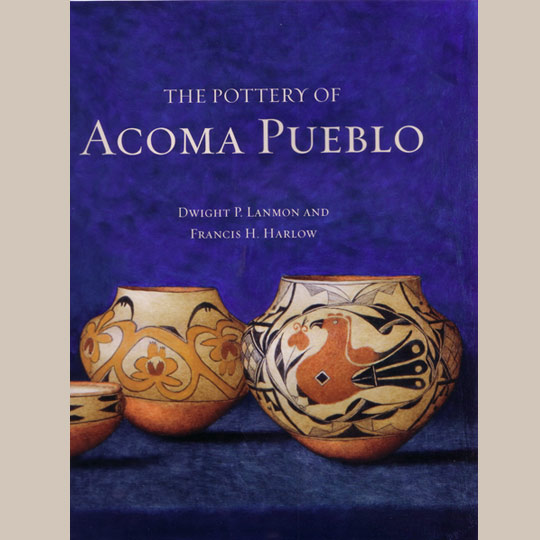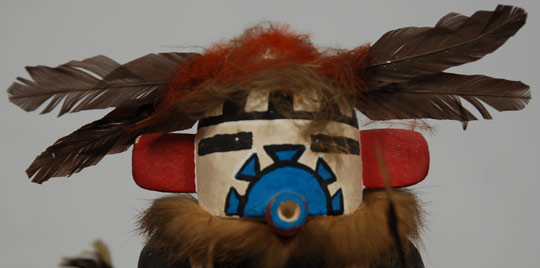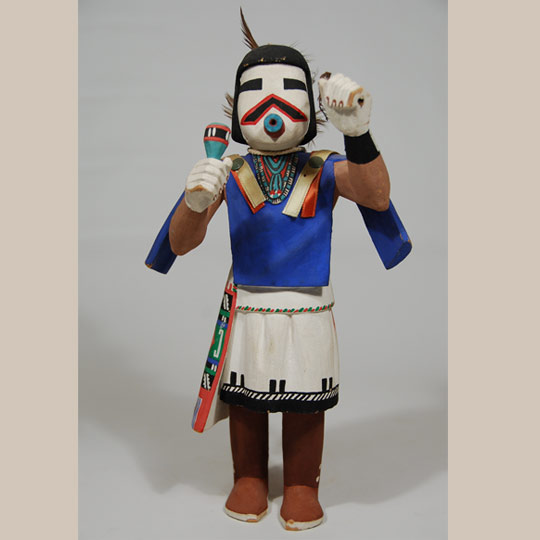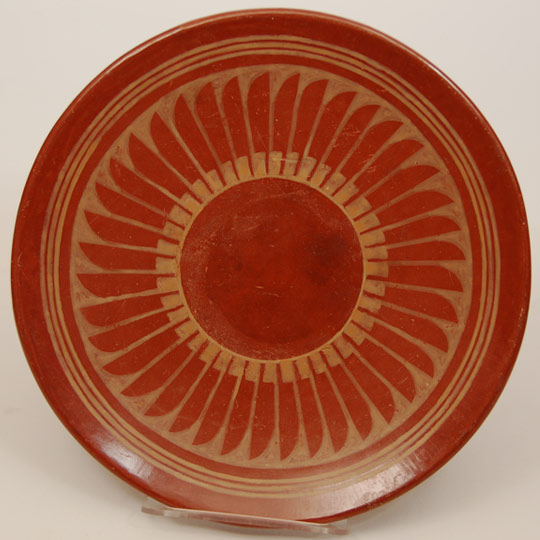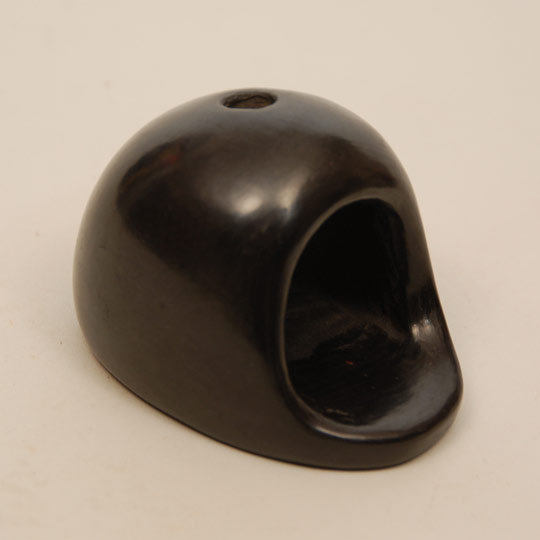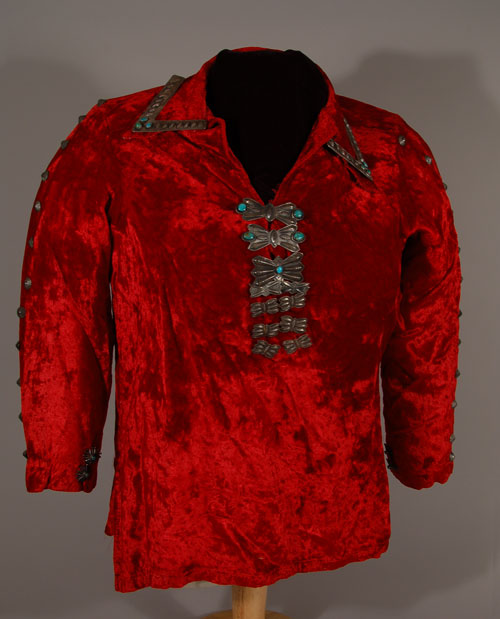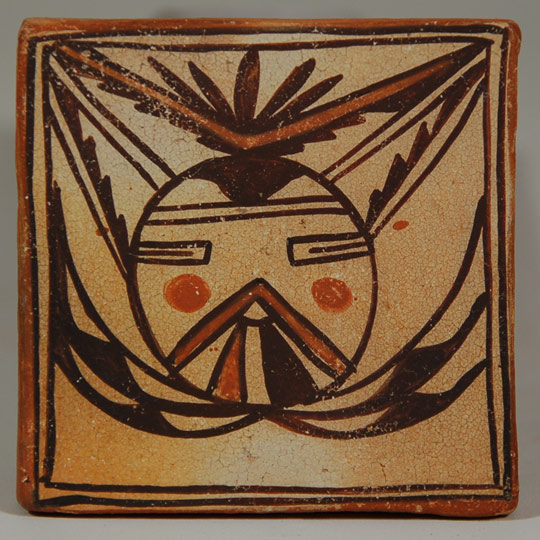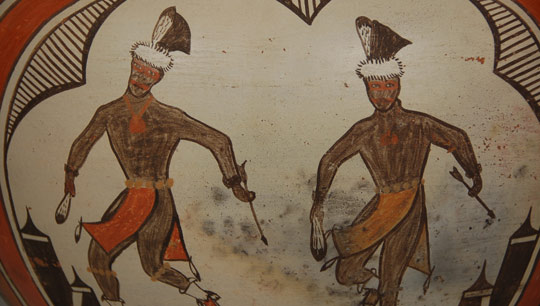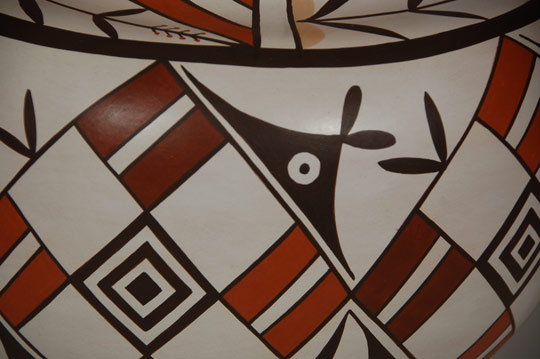Subject: Zuni Pueblo Unidentified Katsina Doll
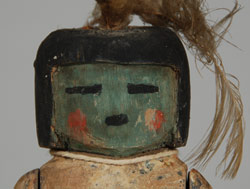 When we originally sold this katsina doll to a client in 2003, we were not able to identify it. Now that we have it back from the estate of that client, we decided to see if we could be more successful in its identification. As we always do when we are stumped regarding a katsina doll, we consulted Chad Burkhardt, noted Katsina expert. Our only input was that it was from Zuni, not Hopi, based on the articulating arms and the dense (not cottonwood) wood.
When we originally sold this katsina doll to a client in 2003, we were not able to identify it. Now that we have it back from the estate of that client, we decided to see if we could be more successful in its identification. As we always do when we are stumped regarding a katsina doll, we consulted Chad Burkhardt, noted Katsina expert. Our only input was that it was from Zuni, not Hopi, based on the articulating arms and the dense (not cottonwood) wood.
Chad's comments were that he agreed it was likely from Zuni Pueblo based on style and material but it is not an identifiable katsina representation that he has seen. He dated it to circa 1940s due to the paint on the legs and feet and the carving of the hands and feet.
When we originally purchased the doll from a client in Kansas City, it was part of a large collection of dolls, approximately 27, all of which were authentic, so we do not doubt the authenticity of this as a Zuni carving, we only do not know what Katsina it represents. It is an excellent carving that is typical of Zuni workmanship.
Condition: very good structural condition with a repair to the left hand and missing item in the other hand. Most of the body paint has worn off which is an indication that it was probably natural pigment, not commercial paint.
Provenance: originally from the collection of a Kansas City family
most recently from the estate of Michael F. Frost
Recommended Reading: Kachinas of the Zuni by Barton Wright
Subject: Zuni Pueblo Unidentified Katsina Doll
Carver Unknown
Category: Traditional
Origin: Zuni Pueblo
Medium: wood, fur, feathers, pigment
Size: 9-1/2" tall
Item # C3360o
Subject: Laguna Pueblo Mudhead Katsina Doll with Ceremonial Bowl
Very little is known about New Mexico Pueblo katsinas or katsina dolls so one must speculate when describing such. At Hopi, we know that Mudhead Katsinas (Koyemsi) serve religious and secular functions so it is assumed the same is true at New Mexico Pueblos. They function as chiefs during the season called Kwiyamuya, and as clowns at other times. They are probably the most popular and recognized of all katsinam.
They appear in almost every ceremony as clowns, drummers, announcers of dances, and other roles. During the rest period in a dance, they may engage in games with the boys and girls in the audience. At other times, only a single Mudhead may appear as a drummer for a group. These katsinam appear in almost every pueblo dance.
The Mudhead Katsina head covering is made from canvas and is covered in mud as is the body of the Katsina. The knots on the mask have been described as representing deformity and are used to pass on to the Hopi that incest is wrong and will result in such deformity. They are used as teaching demonstrations in many occasions.
It was pointed out to us that the white lines on the body of the doll are a New Mexico style of body paint, not the style at Hopi. Also, the black-on-white bowl carried by the katsina doll is most likely a Laguna Pueblo bowl. It is for these two reasons that we are accepting the comments of an informant who contacted us and we are attributing this doll to Laguna Pueblo.
It is assumed that this representation of a Mudhead Katsina is one of a very religious purpose. It is the only completely nude Mudhead Katsina doll of which we are aware. The bowl in his right hand probably holds sacred corn meal and the outward extension of the left hand indicates that he is distributing the corn meal to a person or place.
The pigment used on the head and body appears to be from a natural source and not of a commercial source. The carving may be from the mid-20th century. A metal support stand is provided with the doll.
Recommended Reading: Katsina: Commodified and Appropriated Images of Hopi Supernaturals by Zena Pearlstone
Subject: Hopi Koyemsi (Mudhead) Katsina Doll with Ceremonial Bowl
Carver Unknown
Category: Traditional
Origin: Laguna Pueblo
Medium: wood, pigments
Size: 11-1/2" tall
Item # C3360N
Subject: Zuni Pueblo Chathlashi Katsina Doll
"After the Winter Solstice Ceremonies, each Kiva may give one dance before presenting their Kouupchonane performance, and the Hilili is frequently chosen for this extra dance because it is well liked. When they come to dance the Hilili, named for the kachina' s cry, the Hilili and the Hilili Okya form the usual two lines facing a given direction in the plaza. They do not sing but instead are accompanied by a chorus of singers (tenenakwe) of Chathlashi Kachinas." Barton Wright, Kachinas of the Zuni
This small Katsina doll is one of the Chathlashi mentioned above.
Condition: very good condition with some abrasion and wear to the painted surfaces
Provenance: from the estate of Michael Frost
Recommended Reading: Kachinas of the Zuni by Barton Wright
Subject: Subject: Zuni Pueblo Chathlashi Katsina Doll
Carver Unknown
Category: Traditional
Origin: Zuni Pueblo
Medium: Cottonwood, fabric
Size: 6 3/4" tall
Item # C3360L
Subject: Zuni Pueblo Salimopia Katsina Doll
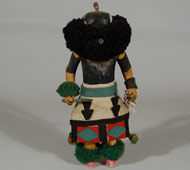 This Salimopia is one of twelve Salimopia. There are two for each of the six directions. Each represents the epitome of youth, vitality, and beauty. They are messengers of the gods, guides for the Katsinas, and warriors. They are young and their actions are quick and darting. Their masks are nearly hidden behind the ruff of crow feathers.
This Salimopia is one of twelve Salimopia. There are two for each of the six directions. Each represents the epitome of youth, vitality, and beauty. They are messengers of the gods, guides for the Katsinas, and warriors. They are young and their actions are quick and darting. Their masks are nearly hidden behind the ruff of crow feathers.
In traditional Zuni form, the arms of the doll have been attached with a nail so that they articulate. Also in traditional Zuni style, the skirt has been elaborately decorated. The body is painted. He carries a yucca staff in each hand and, additionally, in his left hand, he carries sheep scapulae. Yarn is used for the ruff, the armband and ankle bands.
Condition: very good condition
Provenance: from the estate of Michael Frost
Recommended Reading: Kachinas of the Zuni by Barton Wright
Subject: Zuni Pueblo Salimopia Katsina Doll
Carver Unknown
Category: Contemporary
Origin: Zuni Pueblo
Medium: Cottonwood Root, Felt, Yarn
Size: 7-3/4" tall
Item # C3360M
Subject: Hopi Polychrome Jar with Elaborate Decoration
Rondina Huma walked away with awards from the 1996 Santa Fe Indian Market. One of her pieces was awarded "Best of Show," "Best of Division," and "Best Traditional Pottery." She is recognized for her intricate designs, incorporating hundreds of small elements. Her burnishing is exceptional and her painting of designs remarkable.
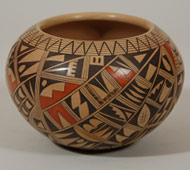 Rondina Huma has been one of the most sought after Hopi potters for over a decade now. She has been featured in many publications and her work is represented in major galleries and museums throughout the country. There is no mystery as to why she has won many awards over the years for her exquisite work. She deserves every accolade bestowed on her. Her pottery is traditional in every manner. She hand coils all her vessels and uses only vegetal and mineral paints. Traditional firing is carried out as well.
Rondina Huma has been one of the most sought after Hopi potters for over a decade now. She has been featured in many publications and her work is represented in major galleries and museums throughout the country. There is no mystery as to why she has won many awards over the years for her exquisite work. She deserves every accolade bestowed on her. Her pottery is traditional in every manner. She hand coils all her vessels and uses only vegetal and mineral paints. Traditional firing is carried out as well.
Condition: structurally in excellent condition. There is some minor abrasion to the painted design in one small triangular design area near the rim. A portion of the artist's signature is worn off but her name is clearly readable.
Provenance: Adobe Gallery sold this to a client in Canada around 1985 and it was returned to the gallery for re-sale in 2005 at which time it was sold to a client in Texas from whose estate we have received it.
Recommended Reading: Canvas of Clay by Edwin Wade and Allan Cooke
Subject: Hopi Polychrome Jar with Elaborate Decoration
Artist / Potter: Rondina Huma (1947 - present)
Category: Contemporary
Origin: Hopi Pueblo
Medium: Native Materials
Size: 3-3/8" deep x 5" diameter
Item # C3360J
Subject: Buff-on-red Tall Neck Jar Signed as Maria / Popovi
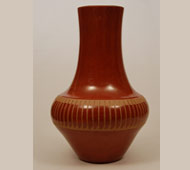 This is a rare early redware jar by Maria Martinez (1887-1980) and Popovi Da (1922-1971). Popovi started working with his mom in 1956. He worked with Maria in all aspects of pottery preparation and their pieces were co-signed. It was his intent to assist his mother and not to take away from her attention that kept him from making pottery on his own. He was going to pursue his career after his mother was no longer making pottery. Unfortunately, he passed away in 1971. It was, at that time, that Maria retired.
This is a rare early redware jar by Maria Martinez (1887-1980) and Popovi Da (1922-1971). Popovi started working with his mom in 1956. He worked with Maria in all aspects of pottery preparation and their pieces were co-signed. It was his intent to assist his mother and not to take away from her attention that kept him from making pottery on his own. He was going to pursue his career after his mother was no longer making pottery. Unfortunately, he passed away in 1971. It was, at that time, that Maria retired.
This jar was made, most likely, between 1956 and 1960. It is co-signed, but not dated. Popovi applied a date to most pieces made after 1960. During the lifetime of this jar, perhaps from the very beginning, it served as a lamp base. The bottom of the jar was drilled for a lamp cord. The drill hole did not mar the signatures.
This is a major effort by Maria and Popovi and is a masterpiece of their collaboration. It demonstrates, once again, that they were among the finest team ever to produce pueblo potter in the mid-20th century.
Condition: a hole was drilled in the bottom to accommodate a lamp cord at one time in the history of the jar. It appears that a slip crack just above the shoulder was professionally repaired. There are a few minor scratches but nothing of great significance.
Provenance: formerly sold by Gallery 10 of Santa Fe and Scottsdale
From the estate of Michael Frost
Recommended Reading: The Legacy of Maria Poveka Martinez by Richard Spivey
Subject: Buff-on-red Tall Neck Jar Signed as Maria / Popovi
Artists / Potters: Maria Martinez 1887-1980 and Popovi Da
Category: Contemporary
Origin: San Ildefonso Pueblo
Medium: Native Materials
Size: 15" tall x 9-7/8" diameter
Item # C3360G
New Book Title: THE POTTERY OF ACOMA PUEBLO
From the Dust Jacket:
THE POTTERY OF
ACOMA PUEBLO
DWIGHT P LANMON AND
FRANCIS H. HARLOW
THE POTTERY TRADITION OF ACOMA PUEBLO is one of the most significant and varied among the Pueblo people of the Southwest. This book traces the history of Acoma pottery over the past seven hundred years. In the pursuit of this project, the authors, foremost authorities in the field, have located, studied, and photographed several thousand examples. They present more than eight hundred here, along with dozens of photographs of potters, several of whom are identified for the first time.
The focus of concentration is on the traditional period (circa 1300-1890) and the transitional period (circa 1880-1930). The modern period is summarized briefly. An important contribution to the literature is the identification of more than nine hundred Acoma potters who worked between about 1880 and the present.
Pottery vessels served the functions of everyday life and ceremonial rites at Acoma Pueblo for centuries, but potters did not consider their pots to be commonplace utensils. Rather they believed them to be sacred and blessed, a gift of Mother Earth. Pottery was thought to have intrinsic, life-giving powers, and vessels took on the attributes of whatever they held.
Acoma pottery has evolved significantly in form and decoration over the past seven hundred years, each change reflecting the interplay of many factors, including technology and style, individual innovations, and changing markets and functions of pottery vessels. The book is a comprehensive illustrated survey of Acoma pottery at a depth and level of detail that has never before been achieved; it will surely be the standard for all studies in the future, indispensable to collectors, researchers, archaeologists, Native arts enthusiasts, and all who appreciate the beauty and heritage of Pueblo ceramics.
Title: THE POTTERY OF ACOMA PUEBLO
Author: Francis Harlow, et al.
Subject: Native American Pottery
Date Published: 2013
Size: 623 pages
Subject: Hopi Nayaiyataka Katsina Doll, circa 1961
This is a rarely carved Katsina doll. He is considered to be a 20th-century import from the Rio Grande Pueblos and this is evident in his dress. He appears in the Hopi Plaza Dances and has the function of aiding in the growth of corn. He is seen annually in the dances, but rarely in the form of a carved doll.
The carving is very well accomplished for a carving from the early 1960s as carvings of that era were not always of the finest quality as haste in completing them was deemed acceptable for a sale to tourists.
Condition: very good condition with some dust evident in the feathers
Provenance: Originally purchased in June 1961, directly on the Hopi Reservation, by Alexander E. Anthony, Jr. Sold to an Adobe Gallery client in 2002 from whose estate it is has been returned to Adobe Gallery
Recommended Reading: Kachinas: a Hopi Artist's Documentary by Barton Wright
Subject: Hopi Nayaiyataka Katsina Doll, circa 1961
Carver Unknown
Category: Traditional
Origin: Hopi Pueblo
Medium: cottonwood, feathers, string
Size: 12-1/2" tall
Item # C3360R
Subject: Hopi Wakas'la'laiya (Cow Herder) Katsina Doll signed Hoyesva
Peter Shelton, Jr. is widely recognized as one of the major carvers of Katsina dolls in the mid-20th century. He and his brother, Henry Shelton, are names recognized by collectors of older carvings. He contributed to a style of more detail such as folds in kilts and shirts. This katsina doll appears to be of the style of his work in the 1950s and 1960s.
When we first received this carving, there was a question in my mind whether it was the First Mesa Shalako Katsina who wears a velvet ribbon shirt or the Navan Katsina who also wears a velvet ribbon shirt. Neither seemed quite correct but both seemed to be possibilities. As I always do when I am unsure about a katsina, I consulted with the expert on Hopi and Zuni Katsinas—Chad Burkhardt. I have known Chad since he was about 10 years old and he would come to the Albuquerque gallery and stand in front of the 10-foot showcase full of Katsina dolls and proceed to name each of them. It was remarkable that a person of that age was so knowledgeable and interested in such an esoteric subject. He said this one is the Wakas'la'laiya (Cow Herder) Katsina.
The Wakas'la'laiya Katsina is the side dancer for Wakas'katsinam (Cow Katsinas) when they come as a group. He has a small round rattle of the type that this doll is holding and is dressed just like this doll. The Wakas'katsinam represent animal spirit messengers to the Rain gods. Their songs and dance movements are prayers for rain, and are symbolic of animals' self-sacrifice in supplying food to sustain life." (Secakuku)
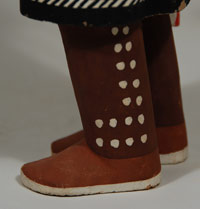 This carving was very well made. The katsina doll stands erect, with one foot slightly in front of the other, as if in the process of taking a step. It stands alone without support or may be hung from the string around its neck.
This carving was very well made. The katsina doll stands erect, with one foot slightly in front of the other, as if in the process of taking a step. It stands alone without support or may be hung from the string around its neck.
The shirt and kilt were carved to show folds, and the ribbons over the shoulder are real, not painted. The painting of the embroidered sash is excellent. The carving is signed Hoyesva under one foot.
Condition: He is in very good condition, with no evidence of damage.
Provenance: from the Michael Frost estate
Recommended Reading: Hopi Katsina: 1,600 Artist Biographies by Gregory Schaaf
Subject: Hopi Wakas'la'laiya (Cow Herder) Katsina Doll signed Hoyesva
Carver: Peter Shelton, Jr. (1920-1992) Hoyesva - Wherever the Arrow Lands
Category: Traditional
Origin: Hopi Pueblo
Medium: cottonwood, ribbon, feathers
Size: 12-1/4" tall
Item # C3360T
Subject: Buff-on-red Pottery Plate signed by Marie & Santana
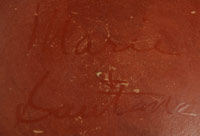 Red ware by Maria Martinez is among the rarest of all pottery she produced. Black ware was so popular with collectors that she rarely fired any red ware. Early pieces like this one by Maria and Santana, produced shortly after Julian passed away, also are rare-maybe even rarer than pieces by Maria and Julian.
Red ware by Maria Martinez is among the rarest of all pottery she produced. Black ware was so popular with collectors that she rarely fired any red ware. Early pieces like this one by Maria and Santana, produced shortly after Julian passed away, also are rare-maybe even rarer than pieces by Maria and Julian.
Condition: This piece is in very good condition, but does exhibit some scratches and abrasions as would be expected on a piece that is over 50 years old.
Provenance: from the estate of Michael Frost
Recommended Reading: The Legacy of Maria Poveka Martinez by Richard Spivey
Artist / Potter: Maria Martinez 1887-1980 and Santana
Category: Contemporary
Origin: San Ildefonso Pueblo
Medium: Native Clay
Size: 8-1/8" diameter
Item # C3360E
Biography: Maria Martinez (1887-1980)
Maria Montoya Poveka Martinez (1887-1980) is probably the most famous of all pueblo potters. She and her husband, Julian, discovered in 1918 how to produce the now-famous black-on-black pottery and they spent the remainder of their careers perfecting and producing it for museums and collectors worldwide.
Early works by Maria and Julian are unsigned (1918-1923).
.gif)
By 1923, Maria began signing Marie on pieces made by her and Julian. His name was omitted because making pottery was "woman's work." Pottery made by Maria and painted by Julian, signed Marie, was most probably made between 1920 and 1925.
.gif)
Pottery made by Maria and painted by Julian between 1925 and 1943 bears the dual signature Marie + Julian. By 1925, and until his death in 1943, Maria shared the signature with Julian.
.gif)
Following the death of Julian, their son Adam and his wife Santana helped Maria with the design and firing of her pottery. Pieces made between 1943 and 1954 are signed Marie + Santana.
.gif)
When Maria began signing pottery, she was told, probably by Chapman, that "Marie" was a more familiar name than "Maria" to the non-Indian public. She therefore signed the name "Marie" for about 30 years. Following the publication of Alice Marriott's book, Maria: The Potter of San Ildefonso, she began signing her true name, "Maria."
.gif)
Around the mid-1950s, Popovi Da began working with his mother, helping her with designing and firing her pottery. They began to co-sign pieces and Popovi started putting a date on each piece, probably around 1959.
.gif)
Maria often made small pieces of pottery without the assistance of her husband, her son, or her daughter-in-law. These are always plain, polished, undecorated pieces and are usually quite spectacular and affordable. They are signed Maria Poveka.
Recommended Reading:
- Recommended Reading: The Living Tradition of Maria Martinez, (click here to view details of book) by Susan Peterson . 1977. Kodansha International, New York. (Available from Adobe Gallery)
- Recommended Reading: Fourteen Families in Pueblo Pottery, (click here to view details of book) by Rick Dillingham. 1994. University of New Mexico Press, Albuquerque. (Available from Adobe Gallery)
- Recommended Reading: Maria, (click here to view details of book) by Richard L. Spivey. 1979, second printing 1981. Northland Publishing. (Available from Adobe Gallery)
- Recommended Reading: The Legacy of Maria Poveka Martinez, (click here to view details of book) by Richard L. Spivey. 2003. Museum of New Mexico Press. (Available from Adobe Gallery)
- Recommended Reading: Maria, The Potter of San Ildefonso, (click here to view details of book) by Alice Marriott. 1948. First edition. University of Oklahoma Press. (Available from Adobe Gallery - Paperback editions may also be available).
Subject: Polished Black Horno signed as Marie & Santana
We mostly think of Maria making major pieces of pottery, but occasionally she must have had a small amount of clay remaining after completing a major piece, and chose to use it to make small items. Also, it must have been a bit relaxing to make small humorous pieces such as animals or hornos or some other non-major piece after just finishing some major undertaking.
This small horno was probably made for use as an incense burner, or perhaps it was just made as a replica of the bread ovens seen around the pueblo.
It is signed Marie & Santana. In crayon is written the date 8-11-56, and a paper price tag indicates a cost of $2.
Condition: original condition
Provenance: from the estate of Michael Frost
Recommended Reading: The Legacy of Maria Poveka Martinez by Richard Spivey
Subject: Polished Black Horno signed as Marie & Santana
Artist / Potter: Maria Martinez 1887-1980 and Santana
Category: Contemporary
Origin: San Ildefonso Pueblo
Medium: Native Clay, Slip
Size: 3-3/4" x 2-5/8" base x 2-1/2" tall
Item # C3360D
Subject: Diné (Navajo) Velveteen Blouse with Silver Buttons
Santa Fe Style fashion has been modeled somewhat from the velveteen clothing of Navajo women. The simple velveteen blouse of the Navajo was expanded to a full dress when converted to Santa Fe Style. Westerners have a vivid picture of what a typical Navajo woman wears while weaving rugs or when attending ceremonial and social occasions. This romanticized vision consists of a beautiful velveteen blouse covered with silver buttons and pins.
This romanticized vision we have today had its beginnings in adverse times for the Navajo. Before the arrival of the Spaniards, Navajo dress consisted of the Pueblo-influenced biil, the two- piece wool dress worn over one shoulder and under the other. In the mid-1800s, westward expansion, resisted by the Navajo, forced the Government to take action against the Navajo in their own lands, eventually imprisoning them at Fort Sumner, New Mexico. During this four-year period of internment, Navajo women who had been taken as servants were taught to sew by their captors. This new style of clothing is a result of this period of capture.
Regardless of the harsh beginnings of this style of clothing, it is now accepted by Navajo women and is standard dress today. This red velveteen blouse is very typical of the traditional style and was purchased on the Navajo Reservation in the 1950s.
The left sleeve of the blouse has 12 small silver buttons on the outer edge and two silver and turquoise buttons on the inner edge. The right sleeve has the same mixture. V-shaped silver repoussé collar tabs are stitched to both collars. On the front of the blouse, from the bottom up, are 8 small repoussé butterfly buttons, above which are three larger silver and turquoise butterfly pins.
Subject: Diné (Navajo) Velveteen Blouse with Silver Buttons
Unknown Maker
Category: Clothing
Origin: Diné - Navajo Nation
Medium: Fabric, Silver, Turquoise
Size: Ladies Medium
Item # 25362
Subject: Hopi Pottery Tile with Salako Mana Katsina Face, pre-1900
Hopi pottery tiles had their beginning as utilitarian objects by the potters of the villages. In making pottery vessels, it is imperative to add a tempering agent to the clay for strength. Occasionally, sand was used as a tempering agent, but more often the potters chose to use fragments of broken pottery. There were times when broken fragments were in short supply, so the potters fashioned square tiles of clay, fired them, then ground them to the fineness of sawdust, and that was their temper.
Thomas V. Keam, an early trader to the Hopi, described this process in his diary. "... the Moki women made frequent reference to the method anciently employed to produce a paste of compact and equable texture, by first molding the clay into tiles, which, after baking, were ground into a fine powder."
Keam was a very astute businessman. He saw the potential for converting these tiles into items that would be saleable to tourists. Keam started collecting decorated tiles as early as 1880. All the early tiles were decorated with Katsina faces or, in some cases, full bodies. It was Keam's influence that led to a production that reached its peak in the 1920s.
When the Santa Fe Railway opened its first Indian Department in 1902, tiles were a featured item. Each tile bore a paper label reading "From the Hopi Villages." At one time, the Indian Department inventory reflected 2700 tiles.
The conversion of tiles from utilitarian to collectibles was not easy. Tiles made for use as temper did not necessarily have to lie flat or even be properly shaped, but when Keam wanted decorated pieces for sale, he expected them to lie flat and be either square or rectangular. Despite its simple form, the tile is one of the most difficult shapes to make. When the potter sets the tiles aside to dry, prior to firing, the flat pieces of clay tend to curl up or crack. Then, when subjected to the firing process, they often explode.
When the Depression hit in the late 1920s, tourist interest in traveling and in collecting waned, therefore the need for tiles disappeared. Very few tiles were made after 1930. Those potters proficient in making them soon passed on and the younger potters chose to make vessel shapes because of the relative ease and success rate in firing.
Historic Hopi tiles are among the rarest of Hopi ceramics. Early ones such as this one were made thicker than those made in the revival period of the late 1900s. This one is ½-inch thick. Modern ones are 1/8th to 1/4th inch thick. This tile features the face of Salako Mana Katsina. A remnant of the paper label on back reads "From the Hopi Villages."
Condition: excellent condition
Provenance: from the collection of a gentleman from Connecticut
Recommended Reading: Hopi & Pueblo Tiles: An Illustrated History by Pat & Kim Messier
Subject: Hopi Pottery Tile with Salako Mana Katsina Face, pre-1900
Potter Unknown
Category: Historic
Origin: Hopi Pueblo
Medium: clay, pigment
Size: 3-1/2" x 3-3/8" x ½" thick
Item # C3363B
Biography: Sofia Medina (1932-2010)
 Sofia Pino married into the Medina family in 1948. She and her new husband Rafael (1929-1998) lived with his grandmother, Trinidad Medina who taught Sofia the techniques of potting. Her mentor, Trinidad, was one of the most talented potters at Zia and Sofia learned well and produced quality wares throughout her life. Sofia used all natural materials in her pottery, including the pigments for painting. Her husband is known for using acrylic paints on pottery after firing.
Sofia Pino married into the Medina family in 1948. She and her new husband Rafael (1929-1998) lived with his grandmother, Trinidad Medina who taught Sofia the techniques of potting. Her mentor, Trinidad, was one of the most talented potters at Zia and Sofia learned well and produced quality wares throughout her life. Sofia used all natural materials in her pottery, including the pigments for painting. Her husband is known for using acrylic paints on pottery after firing.
Sofia used a tan slip on her jars and stone-polished it to a beautiful silky sheen. The design is executed in a soft rose-red slip and brown mineral paint.
Subject: Zia Pueblo Large Polychrome Pictorial Olla
 Sofia Pino married into the Medina family in 1948. She and her new husband Rafael (1929-1998) lived with his grandmother, Trinidad Medina who taught Sofia the techniques of potting. Her mentor, Trinidad, was one of the most talented potters at Zia and Sofia learned well and produced quality wares throughout her life. Sofia used all natural materials in her pottery, including the pigments for painting. Her husband is known for using acrylic paints on pottery after firing.
Sofia Pino married into the Medina family in 1948. She and her new husband Rafael (1929-1998) lived with his grandmother, Trinidad Medina who taught Sofia the techniques of potting. Her mentor, Trinidad, was one of the most talented potters at Zia and Sofia learned well and produced quality wares throughout her life. Sofia used all natural materials in her pottery, including the pigments for painting. Her husband is known for using acrylic paints on pottery after firing.
Sofia used a tan slip on her jars and stone-polished it to a beautiful silky sheen. The design is executed in a soft rose-red slip and brown mineral paint. In this jar, there are four panels of Zia dancers—two panels feature single Antelope dancers and two panels feature a pair of unidentified dancers. The jar is extra-large, larger than the standard water jars, and has fire clouds that attest to an outdoor firing.
Condition: the jar is structurally in excellent condition with only minor spalling of clay and a minor chip on the inner lip of the rim.
Provenance: from the collection of Katherine H. Rust
Recommended Reading: The Pottery of Zia Pueblo by Francis H. Harlow and Dwight P. Lanmon
Artist / Potter: Sofia Medina (1932-2010)
Category: Contemporary
Origin: Zia Pueblo
Medium: clay, pigments
Size: 11-1/4" diameter x 13-1/4" diameter
Item # C3309L
Artist: Max Early (b.1963)
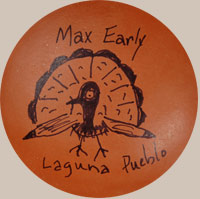 Max Early was born into the Turkey Clan of his mother and Bear Clan of his father at Laguna Pueblo. He grew up with his grandparents. During his early teenage years, he painted some of his grandmother’s pottery. He refined his technique to a personal touch, while maintaining traditional Laguna design symbols and compositions.
Max Early was born into the Turkey Clan of his mother and Bear Clan of his father at Laguna Pueblo. He grew up with his grandparents. During his early teenage years, he painted some of his grandmother’s pottery. He refined his technique to a personal touch, while maintaining traditional Laguna design symbols and compositions.
Since 1994, Early has continued to be honored as a top prize-winning artist at Santa Fe Indian Market. At the same time, he has pursued his higher education degree at the University of New Mexico, leaving little time for making pottery.
Subject: Laguna Pueblo Large Polychrome Olla by Max Early
 Max Early was born into the Turkey Clan of his mother and Bear Clan of his father at Laguna Pueblo. He grew up with his grandparents. During his early teenage years, he painted some of his grandmother's pottery. He refined his technique to a personal touch, while maintaining traditional Laguna design symbols and compositions. A good example is his inclusion of the boxes with split rectangular elements in this jar—elements often seen on historic Laguna pottery.
Max Early was born into the Turkey Clan of his mother and Bear Clan of his father at Laguna Pueblo. He grew up with his grandparents. During his early teenage years, he painted some of his grandmother's pottery. He refined his technique to a personal touch, while maintaining traditional Laguna design symbols and compositions. A good example is his inclusion of the boxes with split rectangular elements in this jar—elements often seen on historic Laguna pottery.
When Early delivered the jar to us, he explained some of the design elements. The black diamond enclosing another black diamond and then enclosing a black box represents Shibot, the eye of God or, as known in Spanish, Ojo de Dios. The diamonds composed of a pair of orange rectangles split by white rectangles and outlined in brown represent planted fields. The black diamonds with a white eye and black pupil represent a bird and the plants on the neck and shoulder are corn.
Since 1994, Early has continued to be honored as a top prize-winning artist at Santa Fe Indian Market. At the same time, he has pursued his higher education degree at the University of New Mexico, leaving little time for making pottery. In addition to being a potter, he is a poet and his first book of poetry is currently being published and will be released shortly.
Take note, in the four vessels we show below as related items, that each of them has a series of the split rectangles mentioned above. These four vessels are historic. Early is continuing the tradition but in a contemporary manner.
Condition: new
Provenance: from the artist
Recommended Reading: Acoma and Laguna Pottery by Rick Dillingham
Subject: Laguna Pueblo Large Polychrome Olla by Max Early
Artist / Potter: Max Early (b.1963)
Category: Contemporary
Origin: Laguna Pueblo
Medium: clay, pigment
Size: 10-3/4" tall x 11-5/8" diameter
Item # C3331B
Subject: Hopi Pueblo Tasap Katsina Doll
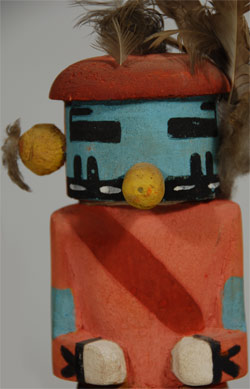 This is an exceptional Hopi Tasap Katsina doll carved from a piece of cottonwood root. Tasap is a Hopi representation of a Navajo God. There are Hopi versions of katsinam that honor and depict other tribes, such as the Navajo, Havasupai, Comanche, Zuni and other Pueblos.
This is an exceptional Hopi Tasap Katsina doll carved from a piece of cottonwood root. Tasap is a Hopi representation of a Navajo God. There are Hopi versions of katsinam that honor and depict other tribes, such as the Navajo, Havasupai, Comanche, Zuni and other Pueblos.
This is the Hopi version of what the Navajo katsinam might look like. These katsinam are not borrowed from the Navajo, as they are unique to the Hopi. They have the same purpose and functions as all the Hopi Katsinam. They are messengers and/or intermediaries to the rain gods. Since they are katsinam in every respect, they are afforded the same reverence and dignity during their visits.
This Tasap male katsinam wears a ceremonial kilt and rain sash, and has a blue face. The male, along with a companion female, appears during Angak'wa and the summer katsina day dances. Since they depict the Navajo, their songs may have some Navajo words speaking of the good things of life and/or words representing moisture.
Condition: The carving is in excellent condition
Provenance:
ex coll Mary Mira of Kansas City
ex coll Michael Frost Estate
Recommended Reading: Kachinas: a Hopi Artist's Documentary by Barton Wright
Subject: Hopi Pueblo Tasap Katsina Doll
Carver Unknown
Category: Traditional
Origin: Hopi Pueblo
Medium: Cottonwood Root
Size: 9-1/2 inches tall
Item # C3360P
Subject: Hopi Pueblo Rugan Katsina Doll
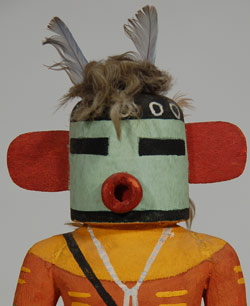 Rugan is a class of katsinas that come in groups, accompanied by the Corn Maidens, who play on rasp musical instruments. There are various types of Rugan Katsinas. This one dates to circa 1940s before the use of shiny acrylic paints. The basic body, legs and head were carved from a single cottonwood root and the ears, mouth and arms were added, typical of the period.
Rugan is a class of katsinas that come in groups, accompanied by the Corn Maidens, who play on rasp musical instruments. There are various types of Rugan Katsinas. This one dates to circa 1940s before the use of shiny acrylic paints. The basic body, legs and head were carved from a single cottonwood root and the ears, mouth and arms were added, typical of the period.
Condition: generally dolls of this age evidence some breakage but this one is still without damage.
Provenance:
ex coll Mary Mira of Kansas City
ex coll Michael Frost Estate
Recommended Reading: Kachinas: a Hopi Artist's Documentary by Barton Wright
Subject: Hopi Pueblo Rugan Katsina Doll
Carver Unknown
Category: Traditional
Origin: Hopi Pueblo
Medium: Cottonwood Root
Size: 10 inches tall
Item # C3360U


